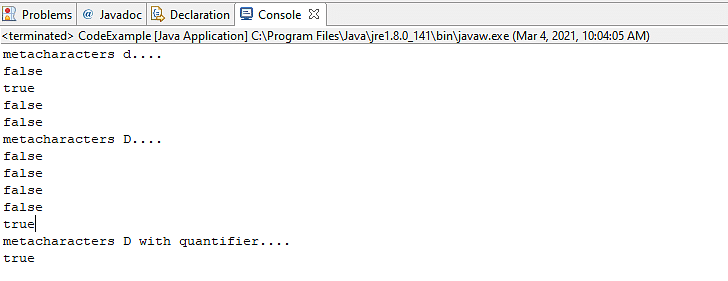
I found the text "FOO" starting at index 0 and ending at index 3.
#JAVA REGEX PREDEFINED CHARACTER CLASSES CODE#
RegexTestHarness.java to create a pattern with case-insensitive matching.įirst, modify the code to invoke the alternate version of compile:Įnter input string to search: FOOfooFoOfoO In the following steps we will modify the test harness, UNIX lines mode can also be enabled via the embedded flag expression (?d). In this mode, only the '\n' line terminator is recognized in the behavior of. Pattern.UNIX_LINES Enables UNIX lines mode.Specifying this flag may impose a performance penalty. Unicode-aware case folding can also be enabled via the embedded flag expression (?u). By default, case-insensitive matching assumes that only characters in the US-ASCII charset are being matched. When this flag is specified then case-insensitive matching, when enabled by the CASE_INSENSITIVE flag, is done in a manner consistent with the Unicode Standard. Pattern.UNICODE_CASE Enables Unicode-aware case folding.Multiline mode can also be enabled via the embedded flag expression (?m). By default these expressions only match at the beginning and the end of the entire input sequence. In multiline mode the expressions ^ and $ match just after or just before, respectively, a line terminator or the end of the input sequence. Pattern.MULTILINE Enables multiline mode.There is no embedded flag character for enabling literal parsing. The flags CASE_INSENSITIVE and UNICODE_CASE retain their impact on matching when used in conjunction with this flag. Metacharacters or escape sequences in the input sequence will be given no special meaning. When this flag is specified then the input string that specifies the pattern is treated as a sequence of literal characters. Pattern.LITERAL Enables literal parsing of the pattern.(The s is a mnemonic for "single-line" mode, which is what this is called in Perl.) Dotall mode can also be enabled via the embedded flag expression (?s).

By default this expression does not match line terminators. matches any character, including a line terminator. Comments mode can also be enabled via the embedded flag expression (?x). In this mode, whitespace is ignored, and embedded comments starting with # are ignored until the end of a line.
#JAVA REGEX PREDEFINED CHARACTER CLASSES FULL#
When this flag is specified, two characters will be considered to match if, and only if, their full canonical decompositions match. Pattern.CANON_EQ Enables canonical equivalence.The flags parameter is a bit mask that may include any of the following public static fields: The Pattern class defines an alternate compile method that accepts a set of flags affecting the way the pattern is matched. It also explores some additional useful methods that we haven't yet discussed. This section explores advanced techniques such as creating patterns with flags and using embedded flag expressions.

The re-seq function is Clojure's regex workhorse.Until now, we've only used the test harness to create Pattern objects in their most basic form.

matches any character including the line terminator.Ĭauses the i flag to use Unicode case insensitivity instead of ASCII. ^ and $ match near line terminators instead of only at the beginning or end of the entire input string. Whitespace and comments in the pattern are ignored. , ^, and $ match only the Unix line terminator '\n'.ĪSCII characters are matched without regard to uppercase or lower-case. See Java's documentation for the class for more details. For example, the pattern #"(?i)yo" matches the strings “yo”, “yO”, “Yo”, and “YO”.įlags that can be used in Clojure regular-expression patterns, along with their long name and a description of what they do. Clojure's regex literals starting with (? ) set the mode for the rest of the pattern. Regular expression option flags can make a pattern case-insensitive or enable multiline mode. ( type # "pattern" ) => ĬlojureScript runs on JavaScript engines and uses Javascript regular expressions.


 0 kommentar(er)
0 kommentar(er)
